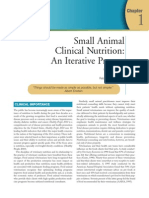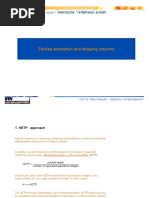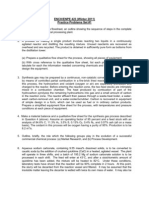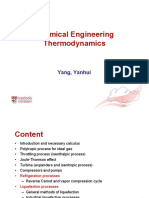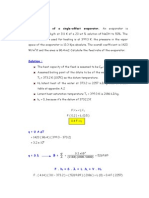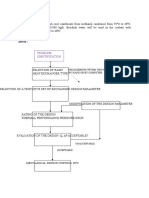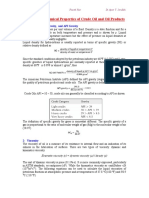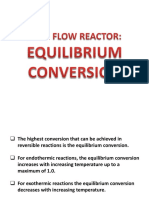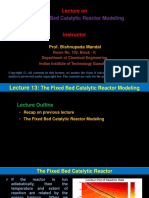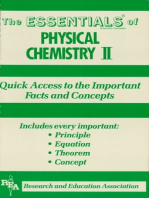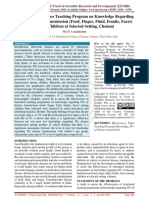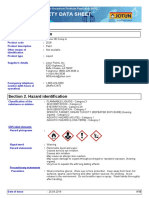Reactor Design II PDF
Reactor Design II PDF
Uploaded by
زينب عباس صيهود شيحانCopyright:
Available Formats
Reactor Design II PDF
Reactor Design II PDF
Uploaded by
زينب عباس صيهود شيحانOriginal Title
Copyright
Available Formats
Share this document
Did you find this document useful?
Is this content inappropriate?
Copyright:
Available Formats
Reactor Design II PDF
Reactor Design II PDF
Uploaded by
زينب عباس صيهود شيحانCopyright:
Available Formats
Reactor Design II-Fourth Year
Dr.Ali N.Khalaf
University of Basrah
College of Engineering
Chemical Engineering Department
Fourth Year
First Semester
Reactor design II
Chapter One
Non-Isothermal Reactors Design
1 Chemical Engineering Department- University of Basrah
Reactor Design II-Fourth Year
Dr.Ali N.Khalaf
1- Optimal Temperatures for Isothermal Reactors:
Reaction rates almost always increase with temperature. Thus, the best temperature for a
single, irreversible reaction, whether elementary or complex, is the highest possible
temperature. Practical reactor designs must consider limitations of materials of
construction and economic tradeoffs between heating costs and yield, but there is no
optimal temperature from a strictly kinetic viewpoint.
Reversible reactions, since these are a special form of multiple reactions, usually exhibit
an optimal temperature with respect to the yield of a desired product. One must specify
the temperature at which to operate. Consider the elementary, reversible reaction
Suppose this reaction is occurring in a CSTR of fixed volume and throughput. It is
desired to find the reaction temperature that maximizes the yield of product B. Suppose
Ef > Er, as is normally the case when the forward reaction is endothermic. Then the
forward reaction is favored by increasing temperature. The equilibrium shifts in the
desirable direction and the reaction rate increases. The best temperature is the highest
possible temperature and there is no interior optimum.
For Ef < Er, increasing the temperature shifts the equilibrium in the wrong direction, but
the forward reaction rate still increases with increasing temperature. There is an
optimum temperature for this case. A very low reaction temperature gives a low yield of
B because the forward rate is low. A very high reaction temperature also gives a low
yield of B because the equilibrium is shifted toward the left. The outlet concentration
from the stirred tank, assuming constant physical properties and is given by
&!" ' (#
𝐶!"#$ = …………………….. ……………….. (1)
)* ' (#* ' (%
We assume the forward and reverse reactions have Arrhenius temperature dependences
! 𝐶𝐵𝑜𝑢𝑡
with Ef < Er . Setting = 0 gives
!#
1%
𝑇",$-./0 = *% +(-%.-# …………………….. ………………. (2)
2 03 -#
2- Influence of Temperature on Reactor Operation:
Because most reactions we not carried out isothermally, we now focus our attention on
heat effects in chemical reactors. The basic design equations, rate laws, and
stoichiometric relationships derived and used in Chapter 4 for isothermal reactor design
are still valid for the design of non-isothermal reactors. The major difference lies in the
method of evaluating the design equation when temperature varies along the length of a
2 Chemical Engineering Department- University of Basrah
Reactor Design II-Fourth Year
Dr.Ali N.Khalaf
PFR or when heat is removed from a CSTR. Thus, in a batch reactor, the temperature of
the reaction mixture may change with time. In a flow reactor, the temperature may
change with time and position, or the feed and effluent streams may have different
temperatures. To account for these effects, reactor analysis must include the energy
balance.
The material and energy balance equations are a coupled set of equations that together
describe the performance of an ideal reactor. Typically, the energy balance is expressed
in terms of the reactor temperature, which may vary with space and time. The nature of
the variations depends on the reactor type and mode of operation.
In perfectly mixed batch reactors, the temperature is the same at all locations in the
reactor, but changes with time as the reaction proceeds.
Sometimes the reactor is operated with heat transfer through the reactor walls, or via
heating or cooling coils inserted into the reactor. Adiabatic operation is also possible. In
a plug flow reactor, the temperature varies with axial position (i.e., in the direction of
flow) in the reactor. There may or may not be heat transfer through the reactor walls. In
a CSTR, the temperature is uniform everywhere in the reactor and is equal to the outlet
temperature. However, the inlet and outlet temperatures are different. There may or may
not be heat transfer with the surroundings, either through the vessel walls or by heating
or cooling coils within the reactor.
There are three types of operation:
- Isothermal Operation.
- Adiabatic Operation.
- Non-isothermal Operation (with heat exchange).
Let’s calculate the volume necessary to achieve a conversion, X, in a PFR for a first-
order, exothermic and adiabatic reaction.
!" $ !$
Material Balance: = ∫&
#!" %!
#
(
Rate Law: 𝑟' = 𝐴 𝑒 𝐶' $%
Stoichiometry: 𝐶' = 𝐶'* (1 − 𝑥 )
!" $ !$
Combine: = ∫& #
#!" '$%
+!" (-($) ' /
We cannot solve this equation because we don’t have x as a function of V or T. We
need another equation. That equation is Energy Balance Equation.
3 Chemical Engineering Department- University of Basrah
Reactor Design II-Fourth Year
Dr.Ali N.Khalaf
3- Energy Balance for Batch Reactors:
The batch reactor is internally uniform in both composition and temperature. The flow
and mixing patterns that are assumed to eliminate concentration gradients will eliminate
temperature gradients as well. Homogeneity on a scale approaching molecular
dimensions requires diffusion. Both heat and mass diffuse, but thermal diffusivities tend
to be orders-of-magnitude higher than molecular diffusivities. Thus, if one is willing to
assume compositional uniformity, it is reasonable to assume thermal uniformity as well.
For a perfectly mixed batch reactor, the energy balance is
𝐻𝑒𝑎𝑡 𝑔𝑒𝑛𝑒𝑟𝑎𝑡𝑒𝑑 𝐻𝑒𝑎𝑡 𝑎𝑑𝑑𝑡𝑖𝑜𝑛 𝑜𝑟 𝑅𝑒𝑚𝑜𝑣𝑒𝑑
$ 2+$ 2 = (𝐴𝑐𝑐𝑢𝑚𝑢𝑙𝑎𝑡𝑖𝑜𝑛 𝑜𝑓 𝐻𝑒𝑎𝑡)
𝑏𝑦 𝑟𝑒𝑎𝑐𝑡𝑖𝑜𝑛 𝑏𝑦 𝐸𝑥𝑡𝑒𝑟𝑛𝑎𝑙 𝐹𝑙𝑢𝑖𝑑
……. (3)
T = reaction temperature K
Ta= External heating or cooling fluid or wall temperature K
A = heat transfer area m2
Cpi = specific heat kJ/Kmol.K
U = overall heat transfer kJ/s.m2.K
∆Hr=Heat of reaction per mole of A reacting
……………………… (4)
3.1 Isothermal operation:
Isothermal operation means dT/dt =0 and therefore T=T0 and
− 𝑉 𝑟$ ∆𝐻% = 𝑈𝐴 (𝑇 − 𝑇& ) …………………………………. (5)
Heat generation = Heat removed
3.2 Adiabatic Operation:
For constant heat of reaction ∆Hr and constant volume
4 Chemical Engineering Department- University of Basrah
Reactor Design II-Fourth Year
Dr.Ali N.Khalaf
………….…………………... (.6)
………….…………………... (7)
3.3 Non-isothermal batch reactor:
The general design material balance equation is still valid and may also be expressed in
terms of fractional conversion, x.
………….…………………... (.8)
This equation is solved with the energy balance equation
𝑁𝐶4 = ∑ 𝜃- 𝐶4-
Note for constant Volume batch reactor use Cp, and for constant pressure batch
reactor use Cv.
5 Chemical Engineering Department- University of Basrah
Reactor Design II-Fourth Year
Dr.Ali N.Khalaf
Example 1:
Consider the reaction A → B, (–rA) = kCA, k350 = 0.65 min–1, (ΔHr) = 30(kcal/mol) in a
10 liter batch reactor with initial concentration of A = 2 mol/l and temperature To = 350
K. Determine the heat transfer rate required to maintain the temperature at 350 K at
95% conversion
Isothermal operation means dT/dt=0 T = To=350 K
Then: Qg =Qr
𝑄( = − 𝑉 𝑟)∆𝐻*
𝑄+ = −𝑉 𝑘 𝐶)∆𝐻* = −𝑉𝑘 ∆𝐻* 𝐶), 𝑒 -./
Qr = –0.65 × 2.0 e–0.65t × 10 × 30
Qr = –390 e–0.65t (kcal/min). Since Q < 0, it shows that heat is removed from
the system, which is undergoing exothermic reaction.
The time corresponding to a 95% conversion for the first order reaction is determined
by
The heat transfer rate (Qt≡95%) at 95% conversion is
Q = –390e–0.65 × 4.608
Q= –19.51 kcal/min
6 Chemical Engineering Department- University of Basrah
Reactor Design II-Fourth Year
Dr.Ali N.Khalaf
Example 2:
Consider the oxidation of carbon monoxide in an adiabatic constant-volume batch
reactor. If the reaction is assumed to be essentially irreversible, it is described by the
'
overall stoichiometry: 𝐶𝑂 + ( 𝑂( → 𝐶𝑂(
The rate of reaction in the presence of water is given by a power law rate expression:
A mixture consisting of 1% CO, 1% O2, 1% H2O, and 97% N2 (mole percentages) is
placed in a constant-volume batch reactor of 0.1 m3 volume at an initial pressure of 1
bar and an initial temperature of 700 K. Calculate the time required to achieve 99%
conversion of the CO, and calculate the pressure and temperature in the reactor at that
time.
∆Hr = - 4.513x103 J/molA
The table of Cv ( J/mol.K) data is presented below
Cv
Solution
The oxidation of CO is a highly exothermic chemical reaction, and, as the reactor is
adiabatic, the energy balance will be quite important. It is thus necessary to solve both
the mole and energy balance equations. We start the solution by considering the mole
balance equation. The mole balance equation for CO can be written in terms of the
concentration because the volume of the reactor is constant. The mole balance is
First note that the number of moles of water, and hence the concentration, is constant
during the reaction, as water does not react and the reactor volume is constant. The
water concentration is given by
The initial concentrations of CO and oxygen can be easily calculated:
7 Chemical Engineering Department- University of Basrah
Reactor Design II-Fourth Year
Dr.Ali N.Khalaf
,
𝑂𝑟 ∶ 𝐶)! = (𝐶*) ))+ (𝛳)! − ( )
With these substitutions and resulting simplification, the rate equation becomes
…………….... (A)
We first develop a stoichiometric table:
Substituting for XCO = 0.99, we calculate the total number of moles present to be 1.711
mol. The volume is unchanged; therefore, the pressure in the reactor is
• If we want to find the temperature at the end of reaction and the reaction time
only.
𝑁𝐶4 = ( 𝜃- 𝐶4-
At inlet 𝜃&5 = 1 ∶ 𝜃56 = 1 ∶ 𝜃&56 = 0 ∶
0
𝑁𝐶- = ∑ 𝜃. 𝐶/. = 19.8 ∗ 1 + 17.13 ∗ 1 = 36.93 123$.5
8 Chemical Engineering Department- University of Basrah
Reactor Design II-Fourth Year
Dr.Ali N.Khalaf
𝟒.𝟓𝟏𝟑∗𝟏𝟎𝟑
𝑻 = 𝟕𝟎𝟎 + 𝟑𝟔.𝟗𝟑 𝒙
𝑻 = 𝟕𝟎𝟎 + 𝟏𝟐𝟐. 𝟐 ∗ 𝒙
𝑻 = 𝟖𝟐𝟏 𝑲
0.172 :.77 𝑑𝑥
𝑡= 1 96:);)
3.37x107 : (<::*)66.6∗?
e (1 − 𝑥)(1 − 0.5𝑥):.6@
The above equation solved by Simpson Rule to find the reaction time.
𝑡 = 318 𝑠𝑒𝑐
• If we want to find the temperature and conversion as a function of time
The general energy balance equation is
For adiabatic operation Q= QRemoved =0. Then:
.
…………….... (B)
For batch reactor
…………….... (C)
9 Chemical Engineering Department- University of Basrah
Reactor Design II-Fourth Year
Dr.Ali N.Khalaf
Substitute Eq. (C) in Eq. (B) gives
AB A? C!/ .∆E% .F! IJ (B9B2 )
= −
A$ A$ (∑ C0 &10 ) (∑ C0 &10 )
&!/ A?
𝑟J = A$
The resulting equations (A, B and C) must be solved simultaneously with the mole
balance, to give the fractional conversion and reactor temperature as a function of time.
The solution of this system of coupled nonlinear ordinary differential equations is
performed numerically, using the Runge–Kutta method.
Or the above equation may written in the finite form as below
∆𝑇 = 𝐶) ∆𝑥 − 𝐶6 ∆𝑡 ( 𝑇 − 𝑇/ ) Energy Balance ……………… (11)
∆𝑥 = 𝐶; 𝑟;J ∆𝑡 𝑀𝑎𝑡𝑒𝑟𝑖𝑎𝑙 𝐵𝑎𝑙𝑎𝑛𝑐𝑒 ....…..….. (12)
𝑟J = 𝑓 (𝑥, 𝑇) 𝑅𝑒𝑎𝑐𝑡𝑖𝑜𝑛 𝑅𝑎𝑡𝑒 ………….. .. (13)
C .∆EF IJ )
𝐶) = ∑ C!/& 𝐶6 = (∑ C 𝐶; = &
0 10 0 &10 ) !/
A plot of the fractional conversion of CO as a function of time is shown in Figure 1.
The temperature increases as the conversion increases, which are the expected result,
because the reaction is exothermic and the reactor is adiabatic. The fractional
conversion reaches 99% after 318 s, at which point the temperature is 821 K.
10 Chemical Engineering Department- University of Basrah
Reactor Design II-Fourth Year
Dr.Ali N.Khalaf
Figure 1: temperature and conversion profile.
4- Energy Balance for Flow Reactors (PFR and CSTR):
Since the reaction is non-isothermal, the temperature will vary along the reaction length
the temperature is related to conversion through energy balance equation:
For a flow reactor:
11 Chemical Engineering Department- University of Basrah
Reactor Design II-Fourth Year
Dr.Ali N.Khalaf
12 Chemical Engineering Department- University of Basrah
Reactor Design II-Fourth Year
Dr.Ali N.Khalaf
.... (14)
This is the general energy balance equation for flow system.
5- Adiabatic Reactors (PFR and CSTR) with constant CP:
The starting equation at steady state is
.... (15)
13 Chemical Engineering Department- University of Basrah
Reactor Design II-Fourth Year
Dr.Ali N.Khalaf
….............. (16)
And the conversion is:
…………………….............. (17)
………………………….............. (18)
#
(
𝑟' = 𝐴 𝑒 $% 𝐶'* ( 1 − 𝑥 )
14 Chemical Engineering Department- University of Basrah
Reactor Design II-Fourth Year
Dr.Ali N.Khalaf
Or we can find the volume by integrating the design equation numerically
𝑉 ? 𝑑𝑥
⎛ ⎞
=1 ⎜ 91 ⎟
𝐹J" : ∆E
2( B/*∑ % ?
⎝𝐶J: (1 − 𝑥)𝐴𝑒 &10K0
⎠
L!/ ? A?
𝑉=& ∫ R .- S ………………..…(19)
!" J : ∆7%
3( 4/5 ;
M ∑ 910:0 ()9N)
Example 3:
The elementary irreversible organic liquid phase reaction is carried out adiabatically in a
flow reactor. An equimolar feed in A and B enters at 27° C, and the volumetric flow
rate is 2 dm3/s and CA0=0.1 kmol/m3.
a) Calculate the PFR and CSTR volume necessary to achieve 85% conversion.
b) What is the maximum inlet temperature one could have so that the boiling point of
the liquid (550° K) would not be exceeded even for complete conversion?
c) Plot the conversion and temperature as function of PFR volume.
d) Calculate the concentration achieved in one 500 dm3 and in two 250-dm3 CSTRs in
series.
HA°(273)= -20 kcal/mol, HB°(273)= -15 kcal/mol, HC°(273)= -41 kcal/mol
CPA=CPB=15 cal/mol.K, CPC=30 cal/mol.K
k = 0.01 dm3/mol.s at 300° K, E =10000 cal/mol
15 Chemical Engineering Department- University of Basrah
Reactor Design II-Fourth Year
Dr.Ali N.Khalaf
Solution Part a:
A+B→C
-
9
𝑘 =𝐴𝑒 34
<""""
9
0.01 = 𝐴 𝑒 <.>?@∗B""
𝐴 = 4.27 ∗ 10@ dm3 /mol. s
. CD@<.E><
@
Then 𝑘 = 4.27 ∗ 10 𝑒 4
Volume of CSTR equals the area of rectangle VCSTR = 0.85 x 206 = 175 dm3
Volume of PFR equals the entire Area under the curve VPFR ~ 305 dm3
16 Chemical Engineering Department- University of Basrah
Reactor Design II-Fourth Year
Dr.Ali N.Khalaf
Solution: Part b
What is the maximum inlet temperature one could have so that the boiling point of the
liquid (550 K) would not be exceeded even for complete conversion?
Solution: Part C
Plot the conversion and temperature as function of PFR volume.
Solution: Part D
O ?9:
=
L!/ F!
For one CSTR:
O ?9:
= . CD@<.E><
L!/
&!/D()9?)DP.6<∗):C M B""5D"";
17 Chemical Engineering Department- University of Basrah
Reactor Design II-Fourth Year
Dr.Ali N.Khalaf
𝑥 = 0.92
For two CSTR
𝑥) . 𝐹J"
𝑉&QB2 ) = 9 @6<).PR) = 500
𝐶J" 6 (1 − 𝑥) )6 4.27 ∗ 10@ 𝑒 ;::*6::?)
𝑥) = 0.881
(?D9?<) .L!/()9?<)
𝑉&QB2 6 = . CD@<.E>< = 250
&!/D()9?D)DP.6<∗):C M B""5D"";D
𝑥6 = 0.97
Example: 4
The reversible first-order gas reaction A⇋R is to be carried out in a CSTR. For
operations at 300 K the volume of reactor required is 100 liters for 60% conversion of
A. What should be the volume of the reactor for the same feed rate and conversion but
with operations at 400 K?
Data: kl = 1x103 exp [-2416/T] min -1
∆Hr = -8000 cal/mol at 300 K
K = 10 at 300 K : Feed consists of pure A : Total pressure stays constant
Solution:
18 Chemical Engineering Department- University of Basrah
Reactor Design II-Fourth Year
Dr.Ali N.Khalaf
Example 5:
The gas-phase reaction A +B→ C is carried out in a pilot plant tubular reactor at about
2 atm and 300oC. The feed rate is 0.120 m3/sec and feed is 40% A, what reactor volume
is needed for 95% conversion under adiabatic operation?
k=1.4x107exp (-7700/T) m3/mol.sec : ∆Hr = -14000 J/mol : CPA = CPB= 15 J/mol.K
Solution:
∑ 𝛳. 𝐶-. =1*15+1.5*15=37.5 J/mol.K
19 Chemical Engineering Department- University of Basrah
Reactor Design II-Fourth Year
Dr.Ali N.Khalaf
14000
𝑇 = 573 + 𝑥 = 573 + 373.3 𝑥
37.5
9<<::
𝑟J = 1.4 ∗ 10< 𝑒𝑥𝑝 𝐶J" ( 1 − 𝑥 ) 𝐶J" (1.5 − 𝑥 )
B
0.4 ∗ 2
𝐶$2 = = 0.017 𝐾𝑚𝑜𝑙/𝑚?
0.082 ∗ 573
𝐹$2 = 0.017*0.12 =0.00204 Kmol/sec
+.KL ⎛
𝑉 𝑑𝑥 ⎞
=i ⎜ AB ⎟
𝐹$2 + ∆G$
( @ C( ## E ∑ *%& I& J
⎝𝐶$+ (1 − 𝑥)(1.5 − 𝑥) ∗ 1.4 ∗ 10 𝑒 ⎠
#!" &.73 !$
𝑉= 2 ∫& ( '0011 )
-.1∗-&0 +!1 (-($)(-.3($) 4563045404.4 7
After the integration by Simpson Rule we can find the volume.
-------------------------------------------------------------
6- Flow Reactors with Heat Exchange:
The general energy balance for continuous flow reactors is given by
6.1- PFR with Heat Exchange:
A nonadiabatic PFR exchanges heat with the surroundings. Several different designs are
used industrially. One possibility would be to impose a constant heat flux at the wall of
the reactor. Such a reactor may be constructed in different ways but the simplest
scenario is illustrated in Figure 2.
This design is very similar to a double pipe heat exchanger, consisting of two concentric
tubes with the central tube acting as the reactor and the surrounding jacket containing
the heat transfer fluid.
20 Chemical Engineering Department- University of Basrah
Reactor Design II-Fourth Year
Dr.Ali N.Khalaf
Fig.2: Jacket PFR -double pipe heat exchanger.
When reactors are operated in the nonisothermal mode, the diameter of the reactor is
usually relatively small so that an effective rate of heat transfer can be achieved. Use of
a small reactor diameter can lead to a requirement of very long reactor length if a large
volume is required. Rather than have a single very long tube, a common design uses
multiple reactor tubes surrounded by a large shell containing the heat transfer fluid,
resembling a shell and tube heat exchanger. This type of arrangement is shown in
Figure 3.
Fig. 3: Multi-tubular reactor used for nonadiabatic operation.
21 Chemical Engineering Department- University of Basrah
Reactor Design II-Fourth Year
Dr.Ali N.Khalaf
Where (a) is heat exchange area per unit volume of the reactor,
J STU P
𝑎=O= FGD
=T
E
U
22 Chemical Engineering Department- University of Basrah
Reactor Design II-Fourth Year
Dr.Ali N.Khalaf
……... (20)
……... (21)
- Solving CRE Problem for Reactors with Heat Exchange:
.. (22)
23 Chemical Engineering Department- University of Basrah
Reactor Design II-Fourth Year
Dr.Ali N.Khalaf
…(23)
If the coolant temperature varies down the reactor we must add coolant balance:
Heat Exchanger Energy Balance- Variable Ta Co-current
Coolant Balance:
….(24)
24 Chemical Engineering Department- University of Basrah
Reactor Design II-Fourth Year
Dr.Ali N.Khalaf
……………. (25)
….……………. (26)
The above Equations (Eq. 20 to Eq. 24) are the general form of the energy balance for a
PFR with external heat exchange. It may be written explicitly in terms of in terms of the
reactor length to give the temperature and conversion profile along reactor length
𝑑𝑉 = 𝐴$#VM 𝑑𝑧 𝐹𝑜𝑟 𝑀𝑢𝑙𝑡𝑖𝑡𝑢𝑏𝑒 𝑅𝑒𝑎𝑐𝑡𝑜𝑟 …………………….. (27)
𝑑𝑉 = 𝐴2M/W$"F 𝑑𝑧 𝐹𝑜𝑟 𝐷𝑜𝑢𝑝𝑙𝑒 𝑃𝑖𝑝𝑒 𝑅𝑒𝑎𝑐𝑡𝑜𝑟 ………………... (28)
STD
𝑑𝑉 = 𝑑𝑧
P
𝒅𝑻 𝑨 .∆𝑯𝒓 .𝒓𝑨 𝑼𝒂 (𝑻(𝑻𝒂 )
= −
𝒅𝒛 𝑭𝑨𝒐 (∑ 𝜽𝒊 𝑪𝑷𝒊 ) 𝑭𝑨𝒐 (∑ 𝜽𝒊 𝑪𝑷𝒊 )
𝑭𝑨𝒐 𝒅𝒙
𝒓𝑨 = 𝑨 𝒅𝒛
𝒅𝑻 ∆𝑯𝒓 𝒅𝒙 𝑨∗𝑼𝒂 (𝑻(𝑻𝒂 )
= −
𝒅𝒛 (∑ 𝜽𝒊 𝑪𝑷𝒊 ) 𝒅𝒛 𝑭𝑨𝒐 (∑ 𝜽𝒊 𝑪𝑷𝒊 )
The above equation may be written in the finite element form as
25 Chemical Engineering Department- University of Basrah
Reactor Design II-Fourth Year
Dr.Ali N.Khalaf
∆𝑇 = 𝐶) ∆𝑥 − 𝐶6 ∆𝑧 ( 𝑇 − 𝑇/ ) Energy Balance …………….. (29)
∆𝑥 = 𝐶; 𝑟;J ∆𝑧 𝑀𝑎𝑡𝑒𝑟𝑖𝑎𝑙 𝐵𝑎𝑙𝑎𝑛𝑐𝑒 ....…..… (30)
𝑟J = 𝑓 (𝑥, 𝑇) 𝑅𝑒𝑎𝑐𝑡𝑖𝑜𝑛 𝑅𝑎𝑡𝑒 …………….. (31)
∆EF J∗I/ J
𝐶) = ∑ K 𝐶6 = L 𝐶; = L
0 &10 !/( ∑ K0 &10 ) !/
The three types of reactor operations yield different temperature profiles within the
reactor and are shown in Figure 4 for an exothermic reaction.
Figure 4: temperature profiles for PFR in three different mode of operation.
6.2- CSTR with Heat Exchange:
26 Chemical Engineering Department- University of Basrah
Reactor Design II-Fourth Year
Dr.Ali N.Khalaf
Figure 5: CSTR with heat exchange.
̇ =0 and 𝑸̇ = 𝑼𝑨(𝑻 − 𝑻𝒂 )
If 𝑾𝒔
Solving for x:
.………… (32)
Solving for T:
.… (33)
Example 6:
A second order, liquid phase reaction, A + B → C, is to be performed in a single-stage
CSTR. Given the following data:
1. Determine the size of the reactor required to achieve 85% conversion of A.
27 Chemical Engineering Department- University of Basrah
Reactor Design II-Fourth Year
Dr.Ali N.Khalaf
Answer: V = 7.56 m3
2. Estimate the heat-transfer area needed to maintain the reactor temperature at 27oC.
Answer: A=3 m2
3. Calculate what the feed temperature must be if the reactor is to be operated
adiabatically at 27oC.
Answer: To = 8.8°C
Example 7: Consider the reaction A → B, rA = k CA, k300 = 0.05 min-1 , ∆Hr = -20
kcal/mole in a 10 liter reactor with CA0 = 2 moles/liter and To =300 K. At what rate
must heat be removed to maintain the reactor isothermal at 300 K for (a) a batch reactor
at 90% conversion?
This is an isothermal reactor with r = 0.05CA. If batch, then
28 Chemical Engineering Department- University of Basrah
Reactor Design II-Fourth Year
Dr.Ali N.Khalaf
Note, however, that the significance of heat removal or addition (Q positive or negative)
is quite different with the batch reactor, requiring a heat removal that varies in time, the
CSTR requiring a constant heat removal rate, and the PFTR requiring a heat removal
rate that varies with position z in the reactor. These are sketched in Figure 6.
Figure 6: heat removal rate that varies with position z or t.
7- Multiple Steady States in a CSTR:
One of the interesting operating features of a nonisothermal CSTR is the existence of
multiple steady states under certain operating conditions. In a reactor with multiple
steady states, there is more than one set of steady-state operating conditions possible.
From a mathematical perspective, the existence of multiple steady states implies that
there is more than one solution (temperature and conversion) that satisfies the mole and
energy balance equations.
In the following, we use some graphical analysis to illustrate how multiple steady states
arise and the implications for reactor operation. A simple first order reaction with a
constant-density fluid is chosen for simplicity, but the principles may be extended to
more complex cases, with a concomitant increase in mathematical complexity.
For illustration purposes, consider a first-order reaction occurring in a nonisothermal
CSTR. The material balance equation is:
O ?
=
L!/ ( &!/ ( )9? )
This equation can be rearranged to give an expression for conversion of A:
('
𝑥X! = )*('
The steady-state energy balance written in terms of conversion and constant heat
capacity is given by Equation.
29 Chemical Engineering Department- University of Basrah
Reactor Design II-Fourth Year
Dr.Ali N.Khalaf
Note that 𝑄̇ = 𝑈𝐴(𝑇 − 𝑇& ) is positive if heat is added to the reactor, that is, when (Ta >
T). The above equation can be rearranged as follows:
.… (34)
……………………………………………… (35)
… (39)
30 Chemical Engineering Department- University of Basrah
Reactor Design II-Fourth Year
Dr.Ali N.Khalaf
Equation 39 is a nonlinear equation. For a given set of operating conditions, the reactor
temperature is the only unknown value in the equation. However, owing to the nature of
the equation, it is possible that under some sets of operating conditions there will be
more than one solution to Equation 39.
The function G(T) represents the rate of heat generation in the reactor. The second
function is R(T) represents the rate of heat removal by heat transfer with the
surroundings and the rate of fluid removal from the reactor. Note that R(T) is a linear
function of temperature in this case because CP and ∆Hr are assumed to be constant. The
intercept of the straight line depends on, for example, the value of the reactor inlet
temperature. A typical behavior of the function R(T) at different inlet temperatures is
shown in Figure 7.
Fig. 7: Variation of heat removal line with inlet temperature.
An increase in the value of the reactor inlet temperature simply shifts the line to the
right, while maintaining the value of the slope. The slope of the curve can be adjusted
by changing the value of (CP0 (1+ κ). Also the linear energy line depends on the value of
κ as shown in Figure 8.
31 Chemical Engineering Department- University of Basrah
Reactor Design II-Fourth Year
Dr.Ali N.Khalaf
Fig. 8: Variation of heat removal line with κ (κ=UA/CP0FA0 ).
A plot of the generation function, G(T), verses T gives a sigmoidal curve because of the
exponential temperature dependence of the rate constant. The shape of the curve
depends in large part on the value of the activation energy. A typical plot is shown in
Figure 9.
.
Fig. 9: Shape of the heat generation function at different reactor temperatures.
32 Chemical Engineering Department- University of Basrah
Reactor Design II-Fourth Year
Dr.Ali N.Khalaf
The shape of the curve depends also on the value of space time τ. A typical plot is
shown in Figure 10.
Fig. 10: Variation of heat generation curve with space-time.
All possible reactor operating temperatures must satisfy both functions, G(T) and R(T),
such that the two functions have equal values. If both of the functions are plotted on the
same graph, the points of intersection of the two lines represent permissible solutions to
the reactor energy and mole balance equations. Figure 11 illustrates such a graph. In this
figure, a single G(T) curve is shown, which would correspond to specific values of the
kinetic parameters and enthalpy of reaction. Multiple R(T) curves are shown, each of
which corresponds to a different reactor inlet temperature, with all other parameters the
same.
Fig. 11: Plot of a single heat generation curve and multiple heats removal curves
33 Chemical Engineering Department- University of Basrah
Reactor Design II-Fourth Year
Dr.Ali N.Khalaf
Consider first the R(T) line that corresponds to the lowest value of the inlet temperature.
This line is at the extreme left of Figure 10. This line intersects the G(T) at a single
point, labeled 1 in Figure 11. This point of intersection corresponds to the only solution
to the mole and energy balance equations; thus this point represents the reactor
operating temperature. If the reactor inlet temperature is increased, with all other
conditions held constant, the R(T) line moves to the right. The sigmoidal G(T) curve is
not affected by the change in the inlet temperature because T0 does not appear in the
expression for G(T). The second R(T) curve from the left intersects the G(T) curve at
two points, marked with points 2 and 6, respectively. Both these points represent
possible operating temperatures for the reactor, the low- and high-temperature stable
operating conditions for this reactor. The next R(T) line in Figure 10 intersects the G(T)
curve at three points, labeled 3, 5, and 7 respectively. Points 3 and 7 represent stable-
steady states. Point 5 is an unstable steady state which cannot be achieved in practice.
Continuing to increase the inlet temperature, the next R(T) curve illustrated has two
stable steady states at 4 and 8, the final curve has a single steady state at point 9.
The steady state that is realized in the reactor depends on either the initial conditions or
the history of the reactor as shown in Figue 12.
Fig. 12: Plot of CSTR stability diagram.
34 Chemical Engineering Department- University of Basrah
Reactor Design II-Fourth Year
Dr.Ali N.Khalaf
Example 8:
Consider a first order adiabatic reaction in a CSTR with the following characteristics:
The rate constant k is expressed as k = exp (15.32 – 7550/T), sec–1.
Determine the operating points for both the mass and heat balance equations.
Solution:
The first order reaction is represented by (–rA) = kCA, and applying the material balance
and the energy balance Equations gives
./
𝑥,- = 01./
35 Chemical Engineering Department- University of Basrah
Reactor Design II-Fourth Year
Dr.Ali N.Khalaf
τ= V/Qo = 15.0/0.05 = 300.0 sec.
0331
H&& I H&& /$K(-3.HL – %
)
𝑥FG = = 0331
-JH&& I -JH&& /$K(-3.HL – )
%
O(L7P
𝑥NG = L-&
The figure shows that the steady state values are (XA, T) = (0.02, 300), (0.5, 362), and
(0.95, 410). The middle point is unstable and the last point is the most desirable because
of the high conversion
Example 9:
Determine the operating conditions in a CSTR for a first order exothermic reaction with
heat transfer under the following conditions:
Feed temperature, TO, = 350 K
Initial concentration, CAO = 1.0 mol/L
Temperature of the cooling medium, Ta = K 350 K
Mean residence time, τ =1.0 min
OP
(ΔHR)= - 200 kJ/mol. 𝐶N2 = 1.0 QRS.T : UA/FA.Cp = 1.0
Reaction rate constant, k= exp (25 – 10000/T) min–1
Solution:
36 Chemical Engineering Department- University of Basrah
Reactor Design II-Fourth Year
Dr.Ali N.Khalaf
𝟏𝟎𝟎𝟎𝟎
9𝟐𝟎𝟎∗𝟏∗𝟏∗𝐞𝐱𝐩 (𝟐𝟓 – 𝐓 )
𝑮(𝑻) = 𝟏𝟎𝟎𝟎𝟎 𝐤𝐉/𝐦𝐨𝐥
𝟏*𝟏∗𝟏∗𝐞𝐱𝐩 (𝟐𝟓 – )
𝐓
𝑘𝜏
𝑥X! =
1 + 𝑘𝜏
10000
1 ∗ exp (25 – )
T
𝑥X! = 10000
1 + 1 ∗ exp (25 – )
T
V$
𝑅(𝑇) = 𝐶N2 (1 + 𝜅)(𝑇 − 𝑇U ) 𝜅=*
%# W'#
𝑹(𝑻) = 𝟏(𝟏 + 𝟏)(𝑻 − 𝟑𝟓𝟎) = 𝟐(𝑻 − 𝟑𝟓𝟎) 𝐤𝐉/𝐦𝐨𝐥
Both G(T) and R(T) at varying effluent temperature. Figure below shows the profiles of
the heat generation and heat removal terms, and the intersections give the operating
conditions. The values of the fractional conversion XA corresponding to the
temperatures at these points are given in the table below.
37 Chemical Engineering Department- University of Basrah
Reactor Design II-Fourth Year
Dr.Ali N.Khalaf
Example 10:
The first order irreversible reaction A(l) → B(l) is carried out in a jacketed CSTR. The
feed contains A and an inert liquid in equimolar amounts, where FA0 = 80 mol/min.
What is the reactor temp when the inlet temp T0 is 450K?
UA= 8000 cal/min·K : Ta= 300K ∆HR=-7500 cal/mol : CpA = CpB =20 cal/mol·K
Cpi =30 cal/mol·K τ=100 min : E=40,000 cal/mol : k=6.6 x 10-3 min-1 at 350K
Solution:
38 Chemical Engineering Department- University of Basrah
Reactor Design II-Fourth Year
Dr.Ali N.Khalaf
Plug rate law into G(T) and simplify
Steady state temp G (T) =R (T) for T0 = 450K
Use design equation to get XA as an explicit equation:
The steady state temperature for T0 = 450K is 400 K
Then x=
39 Chemical Engineering Department- University of Basrah
Reactor Design II-Fourth Year
Dr.Ali N.Khalaf
8-Adiabatic Equilibrium Conversion:
In an exothermic reaction, the value of ∆Hr is negative. Therefore, an increase in the
temperature decreases the value of K, with a concomitant decrease in the equilibrium
yield. A conflict arises between the need for a high temperature to maximize the
reaction rate, and a low temperature to maximize the conversion. For endothermic
reaction, equilibrium conversion increases with increasing temperature. A typical
equilibrium curve and temperature conversion trajectory for the reactor sequence is
shown in Figure 13.
•For exothermic Reactions: As T increases, the equilibrium shifts to the left. i.e. both
K and Xe decreases
•For endothermic Reactions: As T increases, the equilibrium shifts to the right. i.e.
both K and Xe increases
Fig. 13: equilibrium conversion and equilibrium constant for exothermic
and endothermic reactions.
40 Chemical Engineering Department- University of Basrah
Reactor Design II-Fourth Year
Dr.Ali N.Khalaf
Figure 14 shows a typical equilibrium composition line that might be obtained for an
exothermic reaction. The line has an equilibrium conversion near one at low
temperature but the conversion decreases as the temperature increases. Now consider
the performance of two types of reactor, the adiabatic reactor and the isothermal reactor.
For a given set of operating conditions, the adiabatic reaction line governs the
relationship between the temperature and the fractional conversion. Assuming constant
∆Hr and CP, the energy balance equation is:
Fig. 14: The equilibrium line shows the relationship between the temperature and conversion at
equilibrium for a specified starting composition. The adiabatic reaction line shows the maximum
conversion that can be obtained for adiabatic operation for a given inlet temperature. The isothermal
reaction line shows the best conversion for isothermal operation.
A typical adiabatic reaction line is shown in Figure 15 for an arbitrary value of T0. In the
reactor, both the temperature and conversion will increase along this line until the
equilibrium line is encountered at X2 and T2.
At this point, the rate is zero, and the temperature and composition of the process stream
remain constant for any additional reactor volume.
41 Chemical Engineering Department- University of Basrah
Reactor Design II-Fourth Year
Dr.Ali N.Khalaf
Fig. 15: The equilibrium conversion for adiabatic operation.
If the same reactor was operated isothermally, the vertical operating line shown in
Figure 14 would be obtained. As the temperature is constant, the fractional conversion
finally attained, equal to X1, and is higher than that achieved in the adiabatic reactor.
Isothermal operation may not be practical, and does not result in a minimum reactor
volume. It is possible to determine an optimal temperature progression along the reactor
so as to maximize the conversion for the minimum possible reactor volume.
Consider the diagram shown in Figure 15. This diagram shows lines of constant
reaction rate corresponding to set values of temperature and conversion. Each solid line
represents a locus of the set of temperature and conversion that give a specified value of
the rate. The top line corresponds to a rate of zero; in other words, the equilibrium line.
We have already seen that the equilibrium conversion drops as the temperature rises. As
we move from the top to the bottom of the figure, the value of the reaction rate
increases. Note, however, that as the value of the reaction rate increases, the maximum
conversion achievable at that rate decreases.
This observation suggests a route for minimizing the reactor volume. One could start
the reaction at a high temperature to take advantage of the high rate at that temperature,
and then progressively lower the temperature to increase the equilibrium yield.
The dashed line in Figure 16 illustrates the type of temperature and conversion pathway
that must be followed to achieve this optimal design. This reactor design would require
a complex cooling pattern along the reactor length, which might not be practical.
42 Chemical Engineering Department- University of Basrah
Reactor Design II-Fourth Year
Dr.Ali N.Khalaf
Fig 16: Each solid line in this diagram represents a constant value of reaction rate.
Higher conversions than those shown in Figure 16 can be achieved for adiabatic
operations by connecting reactors in series with interstate cooling. Inter-stage cooling
system consists of a series of reactors or catalyst chambers. In each of the reactor stages,
the temperature rises from inlet to outlet. Heat-exchangers (inter-stage coolers) are
placed between the reactor stages as shown in Figure 17, where the temperature is
reduced without affecting the composition of the process stream. The operating line of a
single-reactor does not naturally follow a trajectory that shadows the locus of maximum
reaction rates. By subdividing the reactor into a number of stages and removing heat
from the reaction mixture after each reactor stage, the temperature is forced lower
before the stream enters the next vessel. This allows working closer to the locus of
maximum rates (see Figure 16). Clearly the larger the number of steps, the closer the
trajectory of the system would approach the theoretical optimum. An inordinately large
increase in the number of inter-stage coolers, however, would tend to increase
construction costs. We would need to determine the optimum number of reactor stages.
Fig. 17: Schematic diagrams of two reactors in series.
43 Chemical Engineering Department- University of Basrah
Reactor Design II-Fourth Year
Dr.Ali N.Khalaf
8.1-Multibed Adiabatic Reactors for Equilibrium Limited Reactions:
For relatively fast reactions that are equilibrium limited, the adiabatic reactor is
commonly used in industry. As seen above, the adiabatic reactor experiences a
temperature rise that limits the conversion. Therefore, in applications where very high
conversions are desired, it is common to use multiple reactors in series, with cooling
between each reactor.
Consider, for example, an exothermic reaction that occurs in a series of adiabatic fixed
bed catalytic reactors. The operating path would be similar to the one shown in Figure
18. This plot shows the equilibrium line as a function of temperature and conversion.
For adiabatic operation, the temperature and conversion in the first reactor follow the
adiabatic reaction line denoted Bed 1. When the fraction conversion reaches a value of
X1, which is approaching the equilibrium line, the process stream is cooled by passing it
through a heat exchanger. As this is a catalytic reaction, no further conversion occurs in
this stage, as shown by the flat line. When the process stream is cooled by a
predetermined amount, the stream enters reactor number two, in which it undergoes a
further adiabatic reaction until the conversion is X2.
The stream is cooled as before, and then fed into the last bed, in which the conversion is
brought to X3. Using this strategy, a high level of conversion can be achieved using
adiabatic reactors.A diagram of the reactor that corresponds to Figure 18 and Figure 19.
The exact number of beds and the degree of cooling between the beds depends on the
reaction involved and operating and capital costs.
Fig. 18: Multiple adiabatic reactors in series.
44 Chemical Engineering Department- University of Basrah
Reactor Design II-Fourth Year
Dr.Ali N.Khalaf
Fig. 19: Multiple bed adiabatic catalytic reactor with interstage cooling.
The most classic application of the multibed adiabatic fixed bed reactor is the oxidation
'
of sulfur dioxide 𝑆𝑂( + ( 𝑂( ⇋ 𝑆0? , equilibrium limited reversible reaction. This
reaction is used to make sulfur trioxide, which, when added to water, makes sulfuric
acid. Very high yields are desired (in excess of 99%), but the reaction is highly
exothermic and equilibrium limited. As a result the multibed approach has been
adopted, with typical industrial units having three or four beds.
Example 11:
For the elementary solid-catalyzed liquid-phase reaction: A ⇋ B .Make a plot of
equilibrium conversion as a function of temperature. Determine the adiabatic
equilibrium temperature and conversion when pure A is fed to the reactor at a
temperature of 300 K.
Additional information: CPA = CPB = 50 cal/mol.K : ∆Hr = -20000 cal/molA
Keq (298 K) =100000
Solution:
45 Chemical Engineering Department- University of Basrah
Reactor Design II-Fourth Year
Dr.Ali N.Khalaf
46 Chemical Engineering Department- University of Basrah
Reactor Design II-Fourth Year
Dr.Ali N.Khalaf
47 Chemical Engineering Department- University of Basrah
Reactor Design II-Fourth Year
Dr.Ali N.Khalaf
What conversion could be achieved in Example 11 if two interstage coolers were
available that had the capacity to cool the exit stream to 350 K? Also determine the heat
duty of each exchanger for a molar feed rate of A of 40 moles. Assume that 95% of
equilibrium conversion is achieved in each reactor. The feed temperature to the first
reactor is 300 K.
For an entering temperature of 300 K the adiabatic equilibrium conversion was 0.40.
For 95% of equilibrium conversion, the conversion exiting the first reactor is 0.38.
The first reactor:
The exit temperature from the first reactor is found from a rearrangement of Equation
(e):
𝑋1! = 0.0025(𝑇 − 300)+0
𝑇 = 400 (𝑋 − 0) + 300 = 400 ∗ 0.38 + 300 = 452 𝐾
48 Chemical Engineering Department- University of Basrah
Reactor Design II-Fourth Year
Dr.Ali N.Khalaf
We now cool the gas stream exiting the reactor at 460 K down to 350 K in a heat
exchanger. The gas stream is then sent to the second reactor.
49 Chemical Engineering Department- University of Basrah
Reactor Design II-Fourth Year
Dr.Ali N.Khalaf
Example 12:
The reversible conversion of A+B ⇋ C+D is carried out in liquid phase in a series of
staged PFR's with interstage cooling. The lowest temperature to which the stream may
be cooled is 300K. The feed is equal molar in A and B and contains no C or D. The
PFR's have a sufficient residence time to achieve 99.9% of the equilibrium conversion
in each stage. The feed enters at 300K and the reaction is carried out adiabatically. If
two reactors and one interstage cooler are used, what is the maximum conversion
(±O.05) that may be achieved after the second PFR?
Data: ∆Hr = -40000cal/molA: CPA = CPB = CPC =CPD =53.3 cal/mol.K
Keq (300K) = 3.22x108 FAo = 5 mol A /min
50 Chemical Engineering Department- University of Basrah
Reactor Design II-Fourth Year
Dr.Ali N.Khalaf
The first stage:
∑ 𝛳. 𝐶-. =1*53.3+1*53.3=106.6 cal/mol.K
'+Y.Y(#A?++)
𝑋BX = [++++
𝑋BX = 0.00266(𝑇 − 300)
𝑋BX = 0.00266𝑇 − 0.798
This equation cuts the equilibrium curve at x=0.36 and T= 436 K
51 Chemical Engineering Department- University of Basrah
Reactor Design II-Fourth Year
Dr.Ali N.Khalaf
The second stage:
106.6(𝑇 − 300)
𝑋BX = 0.36 +
40000
This equation cuts the equilibrium curve at x=0.66 and T= 415 K
So the maximum conversion for this system is 0.66
The heat load for the interstage cooling is:
𝑄' = 𝐹$) (1 − 𝑋' )𝐶-$ (300 − 436)
𝑄' = 5 mol A /min(1 − 0.36)53.3cal/mol. K(300 − 436)𝐾
𝑄' = − 23.196 Kcal/min
9-Optimum Feed Temperature:
We now consider an adiabatic reactor of fixed size or catalyst weight and investigate
what happens as the feed temperature is varied. The reaction is reversible and
exothermic. At one extreme, using a very high feed temperature, the specific reaction
rate will be large and the reaction will proceed rapidly, but the equilibrium conversion
will be close to zero. Consequently, very little product will be formed. At the other
extreme of low feed temperatures, little product will be formed because the reaction rate
is so low. A plot of the equilibrium conversion and the conversion calculated from the
adiabatic energy balance is shown in Figure 20.
Figure 20: Equilibrium conversion for different feed temperatures.
52 Chemical Engineering Department- University of Basrah
Reactor Design II-Fourth Year
Dr.Ali N.Khalaf
We see that for an entering temperature of 600 K the adiabatic equilibrium conversion is
0.15, while for an entering temperature of 350K it is 0.75. The corresponding
conversion profiles down the length of the reactor for these temperatures are shown in
Figure 21.
Figure 21: Adiabatic conversion profiles for different feed temperatures.
We notice that the conversion and temperature increase very rapidly over a short
distance (i.e., a small amount of catalyst). This sharp increase is sometimes referred to
as the "point" or temperature at which the reaction "ignites."
If the inlet temperature were lowered to 500 K, the corresponding equilibrium
conversion would increase to 0.38; however, the reaction rate is slower at this lower
temperature so that this conversion is not achieved until closer to the end of the reactor.
If the entering temperature were lowered further to 350 K, the corresponding
equilibrium conversion would be 0.75, but the rate is so slow that a conversion of 0.05
is achieved for the specified catalyst weight in the reactor. At a very low feed
temperature, the specific reaction rate will be so small that virtually all of the reactant
will pass through the reactor without reacting. It is apparent that with conversions close
to zero for both high and low feed temperatures, there must be an optimum feed
temperature that maximizes conversion. As the feed temperature is increased from a
very low value, the specific reaction rate will increase, as will the conversion. The
conversion will continue to increase with increasing feed temperature until the
equilibrium conversion is approached in the reaction. Further increases in feed
temperature for this exothermic reaction will only decrease the conversion due to the
decreasing equilibrium conversion. This optimum inlet temperature is shown in Figure
22.
For reversible, exothermic reactions optimize feed temperature to maximize XA.
High T0: moves XA,EB line to the right. Reaction reaches equilibrium fast, but low XA .
Low T0 would give high XA,e but the specific reaction rate k is so small that most of the
reactant passes through the reactor without reacting (never reach XA,e)
53 Chemical Engineering Department- University of Basrah
Reactor Design II-Fourth Year
Dr.Ali N.Khalaf
Figure 22: Finding the optimum feed temperature.
10- Optimal Temperatures for Isothermal Reactors:
Reaction rates almost always increase with temperature. Thus, the best temperature for a
single, irreversible reaction, whether elementary or complex, is the highest possible
temperature. Practical reactor designs must consider limitations of materials of
construction and economic tradeoffs between heating costs and yield, but there is no
optimal temperature from a strictly kinetic viewpoint. Of course, at sufficiently high
temperatures, a competitive reaction or reversibility will emerge.
Multiple reactions, and reversible reactions, since these are a special form of multiple
reactions, usually exhibit an optimal temperature with respect to the yield of a desired
product.
Example 12:
54 Chemical Engineering Department- University of Basrah
Reactor Design II-Fourth Year
Dr.Ali N.Khalaf
Additional data
(ΔHr) = -70000 J/mol; CP(stream) = 4.2 J/g.K : ρ(stream) = 1000 gm/L;
Solution
The optimum temperature Topt is determined by Equation:
(1) The optimum temperature Topt is:
The minimum volume VR is determined by:
N.L!/
𝑉 = (F
! ) ",$
55 Chemical Engineering Department- University of Basrah
Reactor Design II-Fourth Year
Dr.Ali N.Khalaf
FAO = Qo CAO Therefore, the volumetric flowrate Qo is
(2) The minimum volume is determined by
𝑋. 𝐹'"
𝑉=
(𝑟' ) 𝑜𝑝𝑡
= 288.0 liter
3) The feed temperature TO for the adiabatic operation at the optimal temperature Topt is
determined from
𝜃. 𝐶N . …𝑇2 − 𝑇2N\ † = − 𝑥. ∆𝐻%
𝑥. ∆𝐻%
𝑇2 = 𝑇2N\ −
𝜃. 𝐶N .
𝑇2 = 278.3 𝐾 = 5.1 𝐶 )
56 Chemical Engineering Department- University of Basrah
Reactor Design II-Fourth Year
Dr.Ali N.Khalaf
Algorithm for isothermal reactors. (Source: Fogler, H. S. Elements of Chemical
Reaction Engineering
57 Chemical Engineering Department- University of Basrah
Reactor Design II-Fourth Year
Dr.Ali N.Khalaf
Algorithm for nonisothermal CSTR design
58 Chemical Engineering Department- University of Basrah
Reactor Design II-Fourth Year
Dr.Ali N.Khalaf
Homework Problems:
1 - An elementary second-order liquid-phase reaction occurs in a CSTR. The reactor has
a volume of 1200 L and is heated by a steam jacket.
The feed temperature is 27°C, and the flow rate is 30 L/min. The inlet concentrations
of A and B are 2 mol/L. The desired conversion of A is 60%.
a. Determine the reactor temperature required to achieve the desired conversion.
b. Determine the temperature of the steam in the jacket required to operate the reactor at
the temperature determined in part (a).
2- A tubular flow reactor is to be designed to produce butadiene from butene by
dehydrogenation (gas-phase reaction). The first-order reaction rate expression is written
in terms of the partial pressure of butene as
The constant k has units of mol (hr L.atm) −1. The reaction is endothermic, the reactor is
often operated adiabatically; therefore, steam is often added to the feed to provide
thermal energy for the reaction. For this reactor, the feed is a mixture of 10 mol of
steam for each mole of butene. The reactor pressure is 2 atm and the feed temperature is
650°C. Values of the rate constant at different temperatures are given in the following
table:
Assume that the heat of reaction is a constant 1.1 × 105 J/mol butene. The heat capacity
of the feed stream may be considered constant at 2.1 kJ/kg ⋅ K.
a. Calculate the reactor volume for a 20% conversion of butene if the reactor is operated
isothermally at 650°C with a total inlet molar flow rate of 11000 mol/h.
b. Determine the reactor volume for 20% conversion of butene for a total inlet molar
feed rate of 11000 mol/hr in an adiabatic reactor.
59 Chemical Engineering Department- University of Basrah
Reactor Design II-Fourth Year
Dr.Ali N.Khalaf
3- The following reaction is carried out in an adiabatic plug flow reactor:
Calculate the maximum conversion that may be achieved if the feed enters at 27°C.
Only A and B are in the feed. The following data are available:
4- A first-order endothermic reaction is carried out in a constant-volume batch reactor.
The enthalpy of reaction is 50,000 J/mol. The reactor volume is 1 m3 and contains 1000
kg of mixture. There are initially 10,000 mol of reactant A in the reactor.
The reactor is heated to 400°C, during which time 10% of the initial A reacts. When
the temperature reaches 400°C, the reactor operates adiabatically. The heat capacity of
the mixture is a constant 2000 J/kg. K.
a. After the heating stops, how much time is required to achieve a final conversion of
70% of the A originally present before the heating started?
b. What is the final temperature in the reactor?
5- A first-order liquid-phase exothermic reaction A → B is carried out in a batch
reactor. There is no heat transfer through the reactor wall. The reaction mixture is to be
held at a constant 40°C by the addition of an inert coolant at a temperature of 25°C.
The flow rate of coolant varies with time so as to maintain the reactor temperature at
40°C. The following data are available:
At time t = 0, only compound A is present in the tank at a concentration of 8000
mol/m3. The initial volume is 1.5 m3.
a. Calculate the conversion of A 2 h after the start of the reaction.
b. Calculate the rate of coolant addition 2 h after the start of the reaction.
c. Calculate the total amount of coolant added after 2 h.
60 Chemical Engineering Department- University of Basrah
Reactor Design II-Fourth Year
Dr.Ali N.Khalaf
6- Consider an adiabatic constant pressure batch reactor in which a second-order gas-
phase reaction occurs
A+B→C (−rA ) = kCACB
The rate constant is independent of temperature and equals 0.01m3/mol ⋅ s. The initial
reactor temperature is 450 K and the pressure is 100 kPa. The initial volume of the
reactor is 1.0 m3. The reactor initially contains 30% by volume A, 30% B, and 40%
inerts. The heat capacity of the mixture is a constant CV = 1000J/kg K. The average
molecular mass of the initial material is 30 g/mol. The internal energy change on
reaction is a constant ΔHr = –60 kJ/mol. Calculate
a. The time required to reach 80% conversion
b. The reactor volume at 80% conversion
c. The reactor temperature at 80% conversion
7- Consider an adiabatic plug flow reactor in which a second-order ideal gas-phase
reaction occurs A + B → C The reactor feed is composed of 40 mol% A, 50 mol% B,
and 10 mol% inert material. The total inlet molar flow rate is 10 mol/s. The reactor inlet
temperature is 300 K and the pressure is 101.325 kPa. The reaction rate is
The concentrations are in mol/m3. The enthalpy of reaction at 298 K is equal to −50,000
J/mol. The heat capacities are
A: 10 J/mol . K, B: 5 J/mol .K, C: 15 J/mol. K, and inert: 15 J/mol. K
The desired fractional conversion of A is 80%.
Calculate the reactor volume required.
8- The elementary, reversible gas phase reaction A⇋ B is to be carried out in a CSTR
with heat exchange. Pure A is fed to the reactor. The heat exchange coil in the reactor is
maintained at 400K. The rate coefficient is known at 400K, but heat of reaction is
unknown.
A) Calculate the conversion (X) if the steady state CSTR is operated at 450K.
B) Calculate the heat removal rate R (T) at this temperature.
C) Calculate the heat of reaction (∆Hr).
61 Chemical Engineering Department- University of Basrah
Reactor Design II-Fourth Year
Dr.Ali N.Khalaf
9- A first-order, reversible reaction A⇋ B is taking place adiabatically. The equilibrium
constant at 400 K is 3 and the heat of reaction, which can be assumed constant, is –50
kJ/mole. Pure A with a specific heat of 100 J/mole-K (which is the same as that of B)
enters the reactor at 300 K. The equilibrium conversion as a function of temperature is
plotted in the figure shown below.
1.2
1
Equilibrium Conversion
0.8
0.6
0.4
0.2
0
300 350 400 450 500 550 600 650
Temperature
a. Show the equations that were used for constructing the plot shown.
b. What is the maximum conversion that can be achieved, if the reactor is operated
adiabatically?
c. If two adiabatic reactors are used, with inter-stage cooling, and if the first reactor exit
stream is cooled to 350 K, what maximum conversion can be achieved in the second
reactor? What would be the exit temperature from this second stage?
10 - A first-order irreversible liquid-phase reaction ( A B ) is taking place in a CSTR
. A enters the reactor at 300 K at a concentration of 3 mol/liter. The reactor volume is
18 liters and flow rate of pure A is 0.06 liters/s. Other parameters are:
0
H Rx 5000 cal/mole, C%pA C%pB 30 cal/mole K
7550 -1
k exp(15.32 )s
T
0
The heat generated term given by ( H Rx X)
is plotted in the figure shown
62 Chemical Engineering Department- University of Basrah
Reactor Design II-Fourth Year
Dr.Ali N.Khalaf
6000
5000
Heat Generation Function
4000
3000
2000
1000
0
250 300 350 400 450
Temperature (K)
1- For the conditions given, determine the number of steady states, and the
Conversions and temperatures at these steady states.
2- What is the minimum incoming temperature at which multiple steady states are
possible?
3- What is the maximum incoming temperature above which only one steady state
occurs?
11-Ascertain whether the following exothermic reaction: 2A ⇋2P (k1 and k1 at 80°C)
could be carried out in the reactor shown below:
Calculate the volume and heat removed from the CSTR and the PFR. Do the
magnitudes of the heat being removed appear feasible? Why or why not?
Data:
63 Chemical Engineering Department- University of Basrah
Reactor Design II-Fourth Year
Dr.Ali N.Khalaf
12-The ester of an organic base is hydrolyzed in a CSTR. The rate of this irreversible
reaction is first-order in each reactant. The liquid volume in the vessel is 6500 L. A
jacket with coolant at 18°C maintains the reactant mixture at 30°C. Additional data:
The average heat capacity is approximately constant at 1.0 kcal L-1 °c- 1
.
(a) What is the conversion of ester in the reactor?
(b) Calculate the rate at which energy must be removed to the jacket to maintain 30°C
in the reactor. If the heat transfer coefficient is 15 kcal/sec. m2 K, what is the necessary
heat transfer area?
(c) If the coolant supply fails, what would be the maximum temperature the reactor
could reach?
13-A reaction is carried out in an adiabatic CSTR with a volume of 10000 L. The feed
solution with reactant A, at a concentration of 5 M, is supplied at 10 L/ s. The reaction is
first-order with rate constant:
(a) Calculate the reactor temperature and exit concentration for feed temperatures of
280, 300, and 320 K.
(b) To maintain the reactor temperature below 373 K, a well-mixed cooling jacket at
290 K is used. Show that it is possible to get 90 percent conversion in this reactor with a
feed temperature of 320 K.
14- The reversible, first-order reaction shown below takes place in a CSTR.
64 Chemical Engineering Department- University of Basrah
Reactor Design II-Fourth Year
Dr.Ali N.Khalaf
(a) For a reactor space time of 10 min, what is the conversion for a 300 K operating
temperature? What is the conversion at 500 K? (Remember: the equilibrium constant
depends on temperature.)
(b) If the feed temperature is 330 K and the feed concentration is 5 M, what is the
necessary heat-removal rate per liter of reactor volume to maintain a 300 K operating
temperature?
15- The reaction A + B ⇋ C + D is carried out adiabatically in a series of tubular
reactors with interstage cooling as shown in the figure below. The feed is equimolar in
A and B and enters each reactor at 27oC.
The heat removed between the reactors is - 87.5 kcal/min.
(a) What is the outlet temperature of the first reactor?
(b) What is the conversion of A at the outlet of the first reactor?
(c) Is the first reactor close to equilibrium at the exit?
State any assumptions that you make while solving the problem.
Data:
65 Chemical Engineering Department- University of Basrah
Reactor Design II-Fourth Year
Dr.Ali N.Khalaf
16- A liquid phase exothermic reaction A →B is carried out at 358K in a 0.2 m3 CSTR.
The coolant temperature is 273K and the heat transfer coefficient (U) is 7200
J/min·m2·K. What is the heat exchange area required for steady state operation?
CPA =CPS=20 J/g•K CA0= 180 g/dm3 υ0= 500 dm3/min T0= 313 K
ρ= 900 g/dm3 ∆H°RX(T) = -2500 J/g E=94852 J/mol·K k(313K)= 1.1 min-1
Answer: A=227.4 m2
66 Chemical Engineering Department- University of Basrah
You might also like
- Small Animal Clinical Nutrition 5thDocument21 pagesSmall Animal Clinical Nutrition 5thJairo Pereira100% (1)
- Beechcraft Super King 300 MMT PDFDocument1,429 pagesBeechcraft Super King 300 MMT PDFTomOrt100% (3)
- Production of Drying OilDocument136 pagesProduction of Drying Oilali abdulrahman al-ezziNo ratings yet
- 1165r05320801 Mass Transfer Operations IIDocument9 pages1165r05320801 Mass Transfer Operations IIsobichemNo ratings yet
- Packed Absorption and Stripping Columns: Prof. Dr. Marco Mazzotti - Institut Für VerfahrenstechnikDocument14 pagesPacked Absorption and Stripping Columns: Prof. Dr. Marco Mazzotti - Institut Für Verfahrenstechnikishhh12No ratings yet
- Ejercicios de Ingeniería EconómicaDocument2 pagesEjercicios de Ingeniería EconómicaDiego MoralesNo ratings yet
- Design Project 9.3 Lukman Martinus G G 02111540000115Document12 pagesDesign Project 9.3 Lukman Martinus G G 02111540000115Lukman Martinus GunawanNo ratings yet
- CPD Group 16Document9 pagesCPD Group 16iffatNo ratings yet
- 423 Problem Set 1Document2 pages423 Problem Set 1keithcrosley0% (1)
- Reactor Design IIDocument68 pagesReactor Design IIKORAMA KIEN0% (1)
- Boiler Sizing Guide PDFDocument1 pageBoiler Sizing Guide PDFfmkhan21100% (1)
- Ex 05Document11 pagesEx 05prajesh_bilvaNo ratings yet
- Flash Tank PDFDocument19 pagesFlash Tank PDFMufita RamadhinaNo ratings yet
- The 1,1,2-Trichloroethane: System Acetone-WaterDocument5 pagesThe 1,1,2-Trichloroethane: System Acetone-Waterasdasdasdasd111No ratings yet
- Simulacion de Procesos Unidad 3Document8 pagesSimulacion de Procesos Unidad 3ChecoCastilloNo ratings yet
- Tutorial 2 - DryingDocument3 pagesTutorial 2 - DryingDinesh Kumar VijeyanNo ratings yet
- 29 - Forced Convection Heat Transfer For Laminar Flow in Closed Conditions ME532 Final PDFDocument26 pages29 - Forced Convection Heat Transfer For Laminar Flow in Closed Conditions ME532 Final PDFHassan ElebadiNo ratings yet
- Lecture Notes 3Document70 pagesLecture Notes 3joshuaNo ratings yet
- Chapter 10 - EvaporationDocument28 pagesChapter 10 - EvaporationAndrea ZagastizabalNo ratings yet
- Problem Set 1Document6 pagesProblem Set 1Emilee Noven RamirezNo ratings yet
- Catalysis and Catalytic Reactors: 10.1 CatalystsDocument13 pagesCatalysis and Catalytic Reactors: 10.1 CatalystsKubra Ėdris100% (1)
- Evaporation TutorialDocument2 pagesEvaporation TutorialjayaprinaNo ratings yet
- Heat Transfer Equipment DesignDocument7 pagesHeat Transfer Equipment DesignBhawani Pratap Singh PanwarNo ratings yet
- KR3543-Lecture 2-VLE and Flash Calculation 20192020 - Revised-20190912065536 PDFDocument66 pagesKR3543-Lecture 2-VLE and Flash Calculation 20192020 - Revised-20190912065536 PDFNatasha Mgt JoharNo ratings yet
- Bell Method To Design ExchangerDocument37 pagesBell Method To Design ExchangerHashir AsifNo ratings yet
- Process Dynamics & Control: Muhammad Rashed JavedDocument33 pagesProcess Dynamics & Control: Muhammad Rashed JavedTalha ImtiazNo ratings yet
- Chemical Engineering Reactor DesignDocument9 pagesChemical Engineering Reactor DesigndeltaoperativNo ratings yet
- Tans - Aqueous Ammonium Sulfate - 1958Document2 pagesTans - Aqueous Ammonium Sulfate - 1958Yulia Kurniawati100% (1)
- Chapter 4 م. احسان حبيبDocument22 pagesChapter 4 م. احسان حبيبعبد اللهNo ratings yet
- CEM All Problems Till Quiz1Document8 pagesCEM All Problems Till Quiz1Muhammad Irfan MalikNo ratings yet
- Week 4 - Vapor-Liquid Separation (Multicomponent Distillation)Document19 pagesWeek 4 - Vapor-Liquid Separation (Multicomponent Distillation)psychopassNo ratings yet
- Contoh Soal Evaporasi 7Document2 pagesContoh Soal Evaporasi 7Redinan ChandraNo ratings yet
- Gambar Skema HE: Example 12.1Document5 pagesGambar Skema HE: Example 12.1FarisNo ratings yet
- Lec 3Document4 pagesLec 3Lizbeth Fiallos AvilaNo ratings yet
- Economic Aspects of Setting Up Purge Gas Recovery Unit (PGRU) With Ammonia Production ProcessDocument7 pagesEconomic Aspects of Setting Up Purge Gas Recovery Unit (PGRU) With Ammonia Production ProcessWilly ChandraNo ratings yet
- Chap3-2e SO2 Absorption ExampleDocument8 pagesChap3-2e SO2 Absorption Exampledarkelf_riderNo ratings yet
- 02 Multiple Reaction-2Document49 pages02 Multiple Reaction-2黃湘庭No ratings yet
- Simulation of A Triple Effect EvaporatorDocument19 pagesSimulation of A Triple Effect EvaporatorAnonymous LSPoghJ5n100% (1)
- Double Efect EvapDocument4 pagesDouble Efect EvaparthurNo ratings yet
- Mass Transfer Operations (ENV 425) Problem Set 4: Zewail City of Science and TechnologyDocument3 pagesMass Transfer Operations (ENV 425) Problem Set 4: Zewail City of Science and TechnologyMayar H. HaggagNo ratings yet
- Design of Packed Tower PDFDocument4 pagesDesign of Packed Tower PDFAnonymous FWlt8Y100% (1)
- 11.3 KernDocument78 pages11.3 KernChou ChouNo ratings yet
- Plug Flow Reactor Equilibrium ConversionDocument24 pagesPlug Flow Reactor Equilibrium Conversionblackbeauty14100% (1)
- Continuous ReactionDocument28 pagesContinuous ReactionFucKerWengieNo ratings yet
- 05 Introduction To Multi-Component DistillationDocument30 pages05 Introduction To Multi-Component Distillationchemical08112009100% (1)
- SHMT 2N 1 PDFDocument51 pagesSHMT 2N 1 PDFAmna EhsanNo ratings yet
- ATKDocument4 pagesATKAgung SuharmantoNo ratings yet
- Transport Phenomena and Unit Operations A Combined Approach by Richard G. GriskeyDocument5 pagesTransport Phenomena and Unit Operations A Combined Approach by Richard G. GriskeyRosaNo ratings yet
- Chapter 16 Separation of FluidsDocument7 pagesChapter 16 Separation of FluidsKeshia SaradimaNo ratings yet
- Fluidized-Bed Reactors 2012Document16 pagesFluidized-Bed Reactors 2012Davina NaidooNo ratings yet
- 15CH304 CRE Unit 2 ProblemsDocument9 pages15CH304 CRE Unit 2 ProblemsSri HariNo ratings yet
- Report On Problem 11.2Document10 pagesReport On Problem 11.2Pamela Mae Ucab100% (1)
- Tutorial-8-Examples-Downstream Processing-3-Solutions PDFDocument10 pagesTutorial-8-Examples-Downstream Processing-3-Solutions PDFAlaa SabriNo ratings yet
- Calculation of Bubble and Dew PointDocument9 pagesCalculation of Bubble and Dew Pointrgopinath5No ratings yet
- Thermo 2Document22 pagesThermo 2Rochie DiezNo ratings yet
- Elements of Chemical Reaction Engineering H. Scott Fogler Prentice Hall ParcialDocument1 pageElements of Chemical Reaction Engineering H. Scott Fogler Prentice Hall ParcialJWAN RA YA3QOBNo ratings yet
- Introductory Applications of Partial Differential Equations: With Emphasis on Wave Propagation and DiffusionFrom EverandIntroductory Applications of Partial Differential Equations: With Emphasis on Wave Propagation and DiffusionNo ratings yet
- مفاعلات - د عبد الواحد -1-50Document50 pagesمفاعلات - د عبد الواحد -1-50halshar433No ratings yet
- Chapter 5 Reactor Design and Reactor NetworkDocument57 pagesChapter 5 Reactor Design and Reactor NetworkDhruv JariwalaNo ratings yet
- CREII-Module-3 - Lecture 13 PDFDocument27 pagesCREII-Module-3 - Lecture 13 PDFshubhamNo ratings yet
- Non Isothermal Reactors: Prepared byDocument9 pagesNon Isothermal Reactors: Prepared byاحمد حمید کارسول عزیزNo ratings yet
- Unit 2 - FODE - 2021 - 220201 - 122449Document27 pagesUnit 2 - FODE - 2021 - 220201 - 122449hiegiyuNo ratings yet
- Agoda BID266328183 PDFDocument1 pageAgoda BID266328183 PDFHenokNo ratings yet
- DLL - Tle 9 Week3Document5 pagesDLL - Tle 9 Week3Renz Dela cruz100% (1)
- 30 Rat BCU TechsheetDocument2 pages30 Rat BCU TechsheetBryan OngNo ratings yet
- Stucor Qp-Ec8702Document5 pagesStucor Qp-Ec8702diamond puppyNo ratings yet
- Datasheet RXTX SplitterDocument2 pagesDatasheet RXTX SplitterOsman ÇarhoğluNo ratings yet
- 2017 NEJM Canvas Canagliflozin and Cardiovascular and Renal Events in Type 2 DiabetesDocument14 pages2017 NEJM Canvas Canagliflozin and Cardiovascular and Renal Events in Type 2 DiabetesbernardoNo ratings yet
- Facilitate Learning Session - Crisostomo MateoDocument11 pagesFacilitate Learning Session - Crisostomo MateoCrisostomo MateoNo ratings yet
- TechnoscapeDocument15 pagesTechnoscapePravat KumarNo ratings yet
- Titan Integrity Campus, Bangalore: A Green Building Case StudyDocument34 pagesTitan Integrity Campus, Bangalore: A Green Building Case StudyHARSH VARDHAN SINGH100% (8)
- Section 4.3Document4 pagesSection 4.3Chang BrootNo ratings yet
- Assignment (Environment of Pakistan)Document10 pagesAssignment (Environment of Pakistan)ZAINEB JAVEDNo ratings yet
- Text Slide: Truck and Trailer Inspection WorkshopDocument39 pagesText Slide: Truck and Trailer Inspection WorkshopFatih D. PrasetioNo ratings yet
- Effectiveness of Video Teaching Program On Knowledge Regarding 5Fs of Disease Transmission Food, Finger, Fluid, Fomite, Faces Among Children at Selected Setting, ChennaiDocument3 pagesEffectiveness of Video Teaching Program On Knowledge Regarding 5Fs of Disease Transmission Food, Finger, Fluid, Fomite, Faces Among Children at Selected Setting, ChennaiEditor IJTSRDNo ratings yet
- Pengetahuan Dan Pemahaman Umum 13 - 20Document12 pagesPengetahuan Dan Pemahaman Umum 13 - 20Sinta Fauziah UlfahNo ratings yet
- Chronic Suppurative Otitis Media in AdultsDocument10 pagesChronic Suppurative Otitis Media in AdultsRstadam TagalogNo ratings yet
- CBSC Periodic AssessmentDocument4 pagesCBSC Periodic Assessmentsreelal cgNo ratings yet
- Efficacy of Sinusitis UltrasoundDocument7 pagesEfficacy of Sinusitis UltrasoundYazid MultazamNo ratings yet
- Hal 139-145 PDFDocument7 pagesHal 139-145 PDFCholif TiaraNo ratings yet
- Jenny Talbot: Mountain Bike Rider: 2 Exercise 1Document6 pagesJenny Talbot: Mountain Bike Rider: 2 Exercise 1Cing BawiNo ratings yet
- Technology Transfer Book - November 2021Document208 pagesTechnology Transfer Book - November 2021K04Anoushka TripathiNo ratings yet
- 6 Yoga Breathing Techniques For Weight LossDocument20 pages6 Yoga Breathing Techniques For Weight LossAlexis Singh100% (2)
- Plasmatic First AidDocument1 pagePlasmatic First Aidadriana2011hcNo ratings yet
- Gessler Merlin Cps SystemDocument30 pagesGessler Merlin Cps SystemGabrielNo ratings yet
- Confined Space-1 PDFDocument22 pagesConfined Space-1 PDFRishabh AgnihotriNo ratings yet
- Safety Data Sheet: Barrier 90 Comp ADocument12 pagesSafety Data Sheet: Barrier 90 Comp AVijayakumar S CherukaraNo ratings yet
- Grinder (Small)Document2 pagesGrinder (Small)Farooq MohammadNo ratings yet
- Kami Export - Cc12a.3 StrengthenDocument1 pageKami Export - Cc12a.3 Strengthenbkhmnrq4d6No ratings yet
